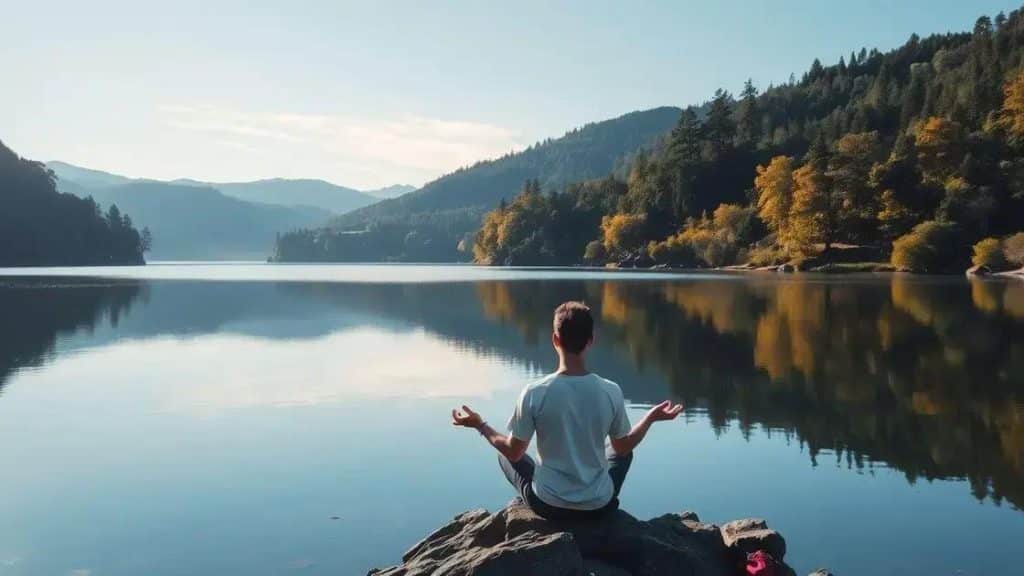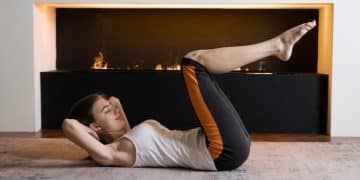Guided visualization for anxiety reduction: find calm within

Guided visualization for anxiety reduction is an effective technique that enhances mental health by promoting relaxation, improving mood, and fostering self-awareness through the use of vivid mental imagery.
Guided visualization for anxiety reduction is a powerful technique to help you find tranquility amidst daily chaos. Ever wondered how a few minutes of focused imagery can transform your mindset? Let’s delve into how this practice can aid in easing anxiety.
Understanding guided visualization
Understanding guided visualization is essential for anyone looking to reduce anxiety. This technique involves using mental imagery to promote relaxation and calmness. It’s like creating a mental movie where you can escape to a peaceful place in your mind.
What is guided visualization?
Guided visualization is a practice that involves focusing your mind on specific images and thoughts. This helps you connect with your inner self. By picturing calming scenes, you can create a sense of tranquility.
How does it work?
The process typically involves listening to a coach or a recording that leads you into a relaxed state. The suggestions given are designed to help you feel safe and comfortable. This results in a deeper relaxation which can alleviate feelings of anxiety.
- Enhances relaxation.
- Reduces stress levels.
- Improves focus on positive outcomes.
As you practice, you might visualize beautiful places like a beach or a quiet forest. Feel the sun warming your skin or the gentle breeze on your face. This helps your body release tension. With each session, you may find it easier to reach a peaceful state.
Types of guided visualization
There are various forms of guided visualization. Some might focus on healing aspects while others might be aimed at stress relief. Experimenting with different types can help you find what resonates best with you. You can try:
- Nature visualization
- Healing light meditation
- Positive outcome visualization
By incorporating these techniques into your routine, you’re not only reducing anxiety but also promoting an overall sense of well-being. Remember, the key is consistency. The more you practice, the more benefits you’ll experience.
Techniques for effective visualization

To harness the power of guided visualization, it’s important to learn effective techniques. These techniques can help you create vivid mental images that support relaxation and reduce anxiety. Utilizing the right methods makes this practice more impactful.
Breathing techniques
Before starting your visualization, focus on your breath. Take deep, slow breaths, letting each inhale bring in calmness and each exhale release tension. This lays the groundwork for a successful visualization experience.
Setting a comfortable space
Your environment plays a significant role. Find a quiet place where you won’t be disturbed. Comfortable seating or lying down can enhance your ability to focus. You might want to dim the lights or use soft music to create a calming atmosphere.
- Choose a quiet setting.
- Use calming sounds or silence.
- Keep the space clean and organized.
With your space ready, it’s time to begin the visualization. Close your eyes and picture yourself in a serene location. Imagine the sights, sounds, and scents around you. For example, think of a peaceful beach with gentle waves. Feel the sand between your toes and the warmth of the sun on your skin. Engaging all your senses makes the experience more vivid.
Guided imagery exercises
You can use specific scripts or recordings to guide your visualization. These can help structure your experience, providing direction and depth. Follow along, allowing the imagery to unfold naturally. Remember, there’s no right or wrong way to visualize.
- Listen to guided recordings.
- Read visualization scripts.
- Practice with a partner or group.
Consistency is key. Integrate visualization exercises into your daily routine. Even five minutes a day can lead to significant benefits over time. As you become more comfortable, you might develop your own personal visuals that resonate deeply with you. This personal touch enhances the effectiveness, making each session feel unique and impactful.
Creating your personal visualization script
Creating your own personal visualization script can significantly enhance your practice. It allows you to tailor the experience to what truly resonates with you. By using your thoughts and feelings, you create a unique journey that can lead to deeper relaxation and recovery from anxiety.
Start with a quiet space
Begin by finding a comfortable, quiet location where you can focus without interruptions. This environment sets the stage for your visualization. You want to make sure you’re relaxed and free from distractions.
Identify your goals
Think about what you want to achieve through guided visualization. Are you looking to reduce stress, promote healing, or boost confidence? Identifying your main goal helps shape your script. For instance, if reducing anxiety is your goal, you might visualize a safe haven where you feel calm.
- Define a clear intention.
- Think of positive outcomes.
- Focus on specific sensations, like peace and warmth.
As you jot down your ideas, consider using descriptive language that engages your senses. For example, instead of simply saying “I am at the beach,” you might say, “I feel the soft sand beneath my feet and hear gentle waves lapping at the shore.” This creates a vivid picture in your mind.
Write your script
When writing your script, keep it personal and specific. Use the first person to make it feel more immediate. You can start by describing the setting in a few sentences, then transition into the feelings and sensations you want to experience. Remember, it’s your script, so it should reflect your personal experiences.
- Use vivid imagery.
- Make it emotionally rich.
- Keep it concise yet descriptive.
Once your script is complete, practice it regularly. You can read it before your visualizations or record it for playback. Revisiting the same script allows you to immerse yourself more deeply in the experience each time. It’s important to revise your script as needed. As you grow, your needs may change, and your visualization should evolve with you.
Benefits of guided visualization on mental health

The benefits of guided visualization on mental health are profound. This technique not only helps with anxiety reduction but also enhances overall emotional well-being. By visualizing positive scenarios, individuals can create a mental space of calm and resilience.
Reduces anxiety and stress
Guided visualization has been known to lower levels of stress. When you engage in this practice, you focus your mind away from daily worries and towards peaceful imagery. This shift not only alleviates anxiety but also can prevent it from escalating.
Improves mood
Using guided visualization regularly can lead to improved mood. As you visualize uplifting scenes, your brain releases endorphins, which are natural mood lifters. Feeling more positive is a key aspect of maintaining mental health.
- Increases feelings of happiness.
- Helps reduce feelings of sadness.
- Boosts overall emotional resilience.
An important part of mental health is developing coping strategies. Guided visualization equips you with these tools. When faced with stressful situations, recalling a positive visualization can help you manage emotions more effectively. This leads to better emotional regulation.
Enhances self-awareness
Engaging in guided visualization promotes self-discovery. By focusing on your thoughts and feelings, you gain insights into your mental state. This practice encourages reflection, helping you understand your triggers and responses to stress.
- Fosters reflection on personal experiences.
- Enhances mindfulness skills.
- Encourages positive self-talk.
Another incredible benefit is the ability to visualize goals. Whether it’s overcoming anxiety or achieving personal milestones, picturing achievable outcomes can motivate you. Your mind becomes a powerful tool in shaping your reality, making it more likely for you to reach your ambitions.
FAQ – Questions About Guided Visualization for Anxiety Reduction
What is guided visualization?
Guided visualization is a technique that involves using mental imagery to promote relaxation and reduce anxiety by focusing on positive, calming scenes.
How can guided visualization help with anxiety?
It helps shift your attention away from stressors, allowing your mind to create a peaceful mental space, which can lower anxiety levels.
Can I create my own visualization scripts?
Yes, writing your own personal visualization scripts can enhance the experience, making it more relevant and effective for your needs.
How often should I practice guided visualization?
Practicing regularly, even just a few minutes a day, can lead to significant benefits over time, improving your mental well-being.





